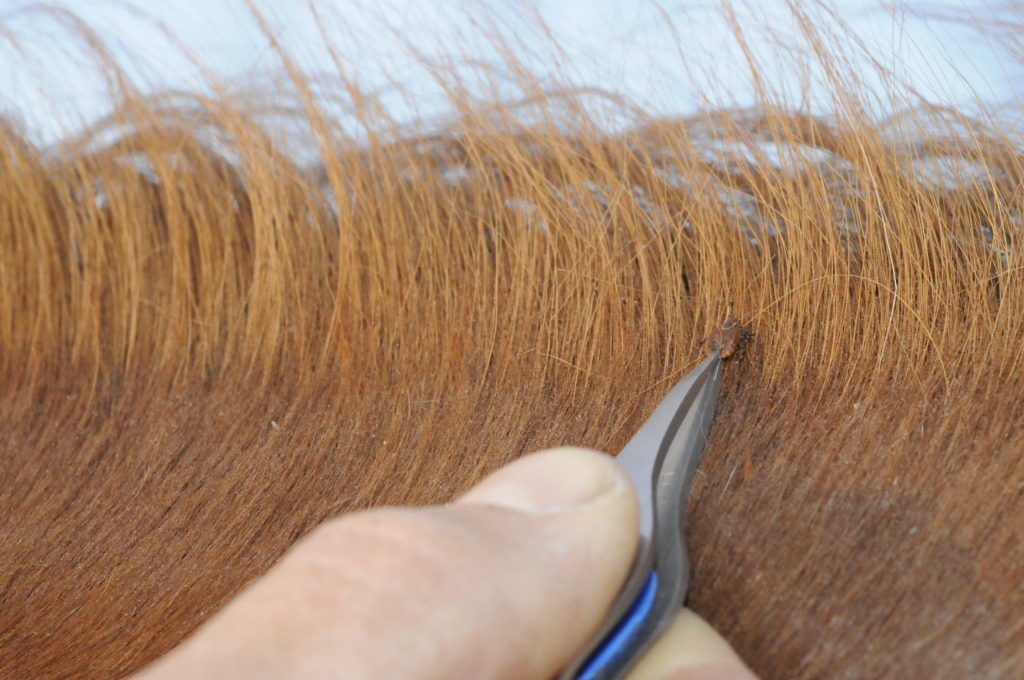Your horse is plainly not himself. He’s gone from perky to plodding in work and he flinches and pins his ears when you groom him. Last week he seemed a little off in front. That lameness improved, but now his hocks seem stiff. What’s going on?
A tiny tick could be the cause of his problems. Ticks, blood-feeding relatives of spiders and mites, can transmit serious diseases through their bites. In this article Linda Mittel, DVM, senior extension associate with Cornell University’s Animal Health Diagnostic Center in Ithaca, New York, helps explain what you need to know.

Horses are susceptible to two serious tick-borne diseases that are widespread in the United States, Mittel says—Lyme disease and equine granulocytic anaplasmosis. We’ll cover both as well as equine piroplasmosis, which is rare in the U.S. Are there other tick-borne threats to horses? Maybe, Mittel says. (See “More Tick Trouble?” below for an update on research into that question being carried out at the AHDC.)
Ticks also transmit many illnesses (including Lyme) to people, dogs and other animals, so they are something to watch out for. These parasites have been around for at least 100 million years, long enough to have fed on (and perhaps spread disease to) dinosaurs. You won’t be able to eliminate them from your horse’s environment, but see “Ticks Be Gone” below for tips on protecting him from their bites.
Blacklegged Biters
Many kinds of ticks carry disease, Mittel says, but blacklegged ticks pose a serious danger to horses because they carry both Lyme disease and equine anaplasmosis. These ticks are widespread in the Northeast, Mid-Atlantic and Great Lakes regions, where they’re commonly known as deer ticks, but they occur in pockets in the South and elsewhere. The West Coast variety is called the Pacific (or western) blacklegged tick.
Blacklegged ticks go through three life stages—larva, nymph and adult—and need a blood meal before molting from one stage to the next. They pick up disease-causing bacteria as larvae and nymphs by feeding on infected mice, and they can pass the bacteria on to their next victim, be it horse or human, dog or deer, or some other mammal or bird. Over the winter, ticks hide in leaf litter and emerge again in spring or whenever the temperature is above 40° F. “Sunny days in the middle of winter can bring the ticks out to ‘quest,’ or look for a meal,” says Mittel. Because the ticks attach tightly when they bite and then stay in place, feeding slowly for days, the bacteria have plenty of time to move into the new host’s bloodstream.
Here’s more bad news: “The ticks are expanding their range,” Mittel says, potentially putting more horses (and people) at risk. The evidence comes from ecological studies as well as serology (blood tests) for infection with Borrelia burgdorferi (Bb), the bacteria that cause Lyme disease. “The infection prevalence determined by the serology shows more exposure to the Lyme organism,” she explains.
What’s behind the increase? Changes in landscape, climate and wildlife populations play roles. The ticks can’t travel far on their own; instead, they hitch rides on deer and other wildlife hosts. As deer and other hosts increase in number and move into new areas, the ticks ride along. They drop off and become established wherever they find conditions to their liking—for instance, former farmland that’s reverting to brush and forest or the shrubby borders of fields and yards. Researchers have noted correlations between warming climate trends and the ticks’ spread farther north. Warm winters are also helping them emerge earlier in spring and stay active longer in fall. That translates to greater risk of infection.
Lyme Disease
Lyme disease is a serious threat to horses with long-term complications that can include chronic lameness and damage to the horse’s nervous system, heart and vision. The disease takes its name from Lyme, Connecticut, where it was first identified in the 1970s. It’s now the most common tick-borne infection in the United States—but, Mittel notes, infection doesn’t always lead to disease.

“Infection is the first step, when the ‘germ’ or agent enters the body,” she explains. Disease occurs when the agent replicates in the body, damaging tissues and producing signs. There are no national statistics on the incidence of Lyme disease in horses, but the increase in positive blood tests shows more exposure to the Lyme organism. “It would make sense that there is more actual disease, but reports are lacking,” she says. Statistics from the Centers for Disease Control show a steady increase in human cases.
Blacklegged ticks are tiny and generally drop off after feeding, so if your horse develops Lyme disease you may never see the guilty tick. How will you know and what should you do?
Signs: Vague and variable signs are a hallmark of this disease. They generally appear weeks after the bite and may include:
- Sporadic lameness, typically involving large joints, such as the fetlock, knee, hock or stifle, and often affecting multiple sites or moving from one site to another
- Lack of energy
- Behavioral changes, such as a sour or depressed attitude
- Hypersensitivity to touch or other stimuli
- Muscle soreness
- Low-grade fever
- Over time, chronic weight loss, leg swelling and other problems.
Most of these signs could be caused by a number of problems—even something as simple as overwork—and that makes diagnosing Lyme disease a challenge.
Diagnosis: The veterinarian will start with a physical exam and a thorough history to assess the horse’s risk of infection. Then, if Lyme seems likely, blood tests may turn up evidence of infection. The simplest is the C6 SNAP, a quick stallside test that detects the presence of antibodies to Bb bacteria. It provides an instant result but doesn’t tell much about the level of antibodies or the stage of the infection.
Laboratory ELISA (enzyme-linked immunosorbent assay) tests measure antibody levels with high levels (200–300 units and above) suggesting infection. This test doesn’t always discriminate well between antibodies to Bb and those produced in response to certain related organisms, though. A Western blot test, which detects antibodies produced against certain proteins in the Lyme bacteria, is more specific.
While these tests have long been used to diagnose Lyme disease, they share two limitations. First, because the horse’s immune system can take several weeks to produce antibodies to a new infection, tests run soon after exposure may yield false negative results. Second, because antibodies can continue to circulate long after the bacteria are gone, a positive test may just indicate past exposure to the bacteria, not active disease.
A multiplex test developed at the AHDC helps overcome the second limitation. It measures antibody levels, like the ELISA, while identifying different antibodies to specific outer-surface proteins of the bacteria. Bb changes the expression of its outer-surface proteins depending on its environment, much as you might change clothes to suit the weather, so the presence of different antibodies can help determine if a Lyme infection is new or old.
For example, during initial infection the bacteria express outer surface protein C (OspC). “Antibodies to OspC are thought to develop about three to five weeks after infection and disappear within four to five months,” Mittel says. Because OspC antibodies indicate recent infection, she says some veterinarians suggest treatment based on positive test results even if the horse isn’t showing signs of active Lyme disease. The goal is to prevent the disease from developing, although the value of the practice hasn’t been determined in horses. “The horse may not develop Lyme disease, so treatment would be unnecessary,” Mittel notes. However, she adds, “It may make sense to consider preventive treatment if the horse is in an area of proven tick activity and has been exposed.”
Once infection is established, antibodies to a different protein, OspF, appear. “OspF may be present for a very long time—years in some cases—whether the horse is treated or not.” A positive test for OspF, then, doesn’t necessarily indicate active disease that must be treated.
Treatment: Most cases of Lyme disease respond to tetracycline antibiotics such as doxycycline or minocycline (both oral) and oxytetracycline (IV). “IV oxytetracycline is known to get the best blood levels in most of the body for Lyme disease,” Mittel says. But IV treatment often means that the horse must stay at a clinic or have the veterinarian visit daily, which can be expensive. “Oral treatments do not achieve the same levels, but many veterinarians use the oral products and feel they see an improvement.” IV treatment may be recommended if the horse doesn’t respond to oral medication or relapses after treatment.
Although many horses show improvement within days of starting antibiotics, the bacteria won’t be eliminated that fast. Treatment generally continues for 30 days or more.
Outlook: When Lyme disease is recognized and treated early, the outlook for recovery is good. Some horses suffer recurring attacks of Lyme disease, and it’s not clear whether they are reinfected or are harboring the bacteria between attacks. In any case, the longer the disease goes untreated, the greater the risk of lingering effects and lasting damage to joints and other areas.
Neurological effects often take months to appear, although they have been reported anywhere from two to 730 days after infection. These effects are not common. But, Mittel says, “It is very difficult to confirm a diagnosis. Therefore, there may be more cases than are reported.” The diagnosis is confirmed by examination of brain tissue after the horse’s death.
Prevention: The best way to protect your horse from Lyme disease is to limit his exposure to the ticks that carry it. There is no approved equine Lyme vaccine and currently no effort to bring one to market. A canine vaccine is available and in high-risk areas some veterinarians give it to horses. No research shows that it prevents Lyme disease in horses, though. And while horses respond to the vaccine by producing antibodies, a Cornell study published last year found that the response is weak and short-lived.
Anaplasmosis
The bacteria that cause equine granulocytic anaplasmosis, Anaplasma phagocytophila (formerly Ehrlichia equi), take the same route as the Lyme bacteria—picked up from mice or other small animals by ticks in the nymph stage and passed on when the ticks seek their next blood meal. As with Lyme, the risk is highest in the areas and at the times when the ticks are active—and as those areas and times increase, so do reports of the disease.

“More cases of anaplasmosis are being seen in horses,” Mittel says. “We are getting positives in areas where veterinarians have not seen the disease before. Since ticks are often co-infected with Borrelia and Anaplasma, it appears that both agents are showing up in new areas.” Sometimes ticks transmit both in the same bite.
Signs: Once in the horse’s bloodstream, the bacteria attack white blood cells called granulocytes. Signs typically appear a week or two after a tick bite. They include:
- Fever, which may be high (103–104° F) for the first one to three days
- Depression and lethargy
- Loss of appetite
- Reluctance to move
- Swelling in the lower legs
- Muscle stiffness.
Older horses may be more severely affected. Mittel notes that any horse with a high fever and no appetite is at risk for serious problems, including dehydration and colic, so you should call the vet promptly if you see those signs.
Diagnosis: If the horse’s history and physical signs point to anaplasmosis, blood tests can confirm the infection. A PCR (polymerase chain reaction) test detects segments of Anaplasma DNA; other tests check for levels of antibodies produced to fight the infection.
Treatment: The tetracycline antibiotics used to fight Lyme disease are also effective against anaplasmosis without the need for prolonged treatment. “Treatment with IV oxytetracyline often causes a very quick resolution of clinical signs—within 24 to 48 hours or even less,” Mittel says. “Many veterinarians will treat anaplasmosis for two to three days IV and then switch to one of the oral tetracyclines, such as doxycycline or minocycline, for a longer course of about seven days.”
Outlook: With treatment horses generally recover promptly without lingering effects and they seem to develop a natural immunity that protects them from this disease for up to two years.
“Anaplasma has been reported to cause ataxia [incoordination]. I have had clients with horses that were unstable on their feet early in the disease, usually the first day,” Mittel says. “In my experience these animals recover with no residual neurological signs.”
Prevention: As with Lyme, there’s no vaccine against this disease. Reducing exposure to ticks is the best defense.
Piroplasmosis
Equine piroplasmosis is considered a foreign disease in the United States, but it’s endemic to Mexico and occasionally turns up north of the border. It’s caused by parasitic protozoa (Theileria equi or Babesia caballi) that are harbored by various (mostly tropical) ticks and spread through their bites. The protozoa attack red blood cells, causing depression, fever, anemia and other signs. Piroplasmosis can be fatal, but it’s often mild with few problems beyond weakness and loss of appetite. Some horses become carriers, showing few signs.
Outbreaks of piroplasmosis are reported to the USDA. Horses who test positive are quarantined and may be euthanized or shipped out of the country to prevent spread. In 2009 a large outbreak occurred on the vast King Ranch in southern Texas, affecting hundreds of horses. Scientists were able to identify cayenne ticks as the main vectors on the ranch. And the size of the outbreak gave them a chance to test what turned out to be the first effective treatment for piroplasmosis—a series of high doses of the drug imidocarb.
“There has not been an outbreak so large since,” Mittel says. Several small U.S. outbreaks have involved the use of shared hypodermic needles or contaminated blood products, which can also spread piroplasmosis. The horses were racing Quarter Horses with links to Mexico, where the infection likely originated.
More Tick Trouble?
Lyme disease, anaplasmosis and piroplasmosis are the only tick-borne diseases known to affect U.S. horses. But that doesn’t mean no others exist—only that none have been discovered and reported.
Blacklegged ticks harbor different species of Borrelia that may turn out to be associated with disease in horses, Mittel explains. And they’re not the only disease carriers—dog ticks, lone star ticks and other tick species carry various infections. In all, ticks are known to transmit more than a dozen diseases to people, including tularemia and Rocky Mountain spotted fever. “There have been no reports of these diseases affecting horses and horses may not be susceptible to the organisms that cause them. But with improved diagnostic tests, we may be surprised,” she says.
Researchers at the AHDC are in the final stages of a multi-year project aimed at identifying other diseases that ticks may be spreading. Mittel says, “We have found potentially novel tick-borne infections in the horse that may be associated with fevers of unknown origins,” including various species of Anaplasma and Ehrlichia. The group hopes to release more specific findings later this spring or summer.
Ticks Be Gone

If you live in blacklegged tick country, take these steps to reduce your horse’s risk:
- Apply fly repellents that contain permethrins, which can discourage ticks from attaching to your horse. Use these products whenever ticks are active—during early spring, fall and winter warm spells—not just when flies are bothersome.
- Groom your horse daily with special attention to top tick-bite zones like the base of the mane and tail and around the ears, throatlatch and belly. If you find a tick, use tweezers to grasp it right at the skin where its mouthparts are embedded. Pull gently up to remove the tick and then kill it.
- Make ticks unwelcome in your horse’s turnout space. Get rid of their favorite hangouts by keeping the grass mowed, clearing brush and trimming low branches.
The U.S. Centers for Disease Control and Prevention has more tips and information that can help you and your horse avoid tick-borne diseases (https://www.cdc.gov/ticks/).
This article was originally published in the May 2018 issue of Practical Horseman.











